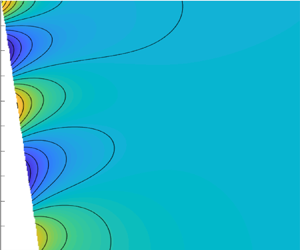Article contents
The effects of vertical mixing on nonlinear Kelvin waves
Published online by Cambridge University Press: 28 September 2020
Abstract

Submesoscale processes along coastal boundaries provide a potential mechanism for the dissipation of mesoscale kinetic energy in the ocean. Since these processes occur on scales not generally resolved by global ocean models, a physically motivated parametrisation is required to accurately describe their effects. Submesoscale dynamics is characterised by strong turbulent mixing, nonlinearity and topographic effects; all of which significantly modify the flow. A major component of the submesoscale boundary response to mesoscale forcing is the Kelvin – or coastally trapped – wave field, which has been shown to transport energy over large distances. This paper thus examines the influence of vertical mixing, nonlinearity and steep-slope topography on baroclinic Kelvin waves with the aim of assessing the importance of these effects. We consider the limit of a steep coastal boundary, weak mixing and weak nonlinearity and perform an asymptotic analysis to determine the modification of the classical Kelvin wave solution by these effects. Linear and nonlinear solutions are given and different mixing limits are discussed and compared with previous work. We find that vertical mixing acts to damp slowly propagating Kelvin waves while nonlinearity can cause wave breaking which may be important for fast waves. Steep-slope topography acts to modify the wave speed and structure consistent with previous work.
- Type
- JFM Papers
- Information
- Copyright
- © The Author(s), 2020. Published by Cambridge University Press
References
REFERENCES
- 2
- Cited by





